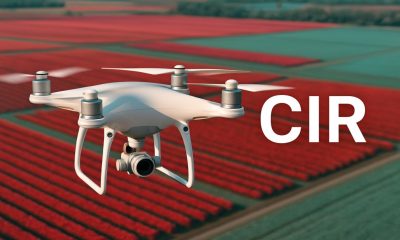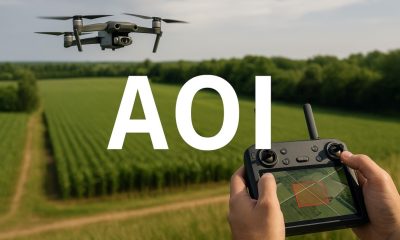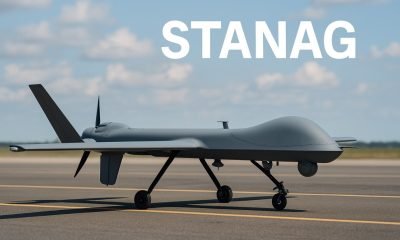- Acronym Guide
- AAM
- ABS
- AC
- ACAS
- ADS-B
- AFAC
- AGL
- AI
- AIM
- ALS
- AM
- AMA
- ANSP
- AOI
- APPI
- AUV
- AUVSI
- ARPAS-UK
- ASTM
- ATC
- BVLOS
- CAA
- CAAC
- CAB
- CASA
- CATT
- CBO
- CBR
- CBRN
- CDMA
- CDR
- CFR
- CIR
- COA
- COMINT
- CORS
- COTP
- COTR
- CPTED
- CV
- C2
- DAA
- DEM
- DFI
- DFS
- DGCA
- DHS
- DOD
- DPA
- DPEs
- DRG
- DRO
- DSM
- DSMX
- DSP
- DSSS
- DTM
- EASA
- EFT
- EO
- EOD
- EO/IR
- ELINT
- EMI
- ESC
- EVLOS
- eVTOLs
- FAA
- FCC
- FCS
- FHSS
- FICCI
- FLIR
- FOB
- FOV
- FPS
- FPV
- GBDAA
- GCP
- GCS
- GDPR
- GML
- GNSS
- GPS
- GSD
- GVC
- HDR
- HOGE
- IACRA
- ICAO
- ICS
- IMU
- INS
- IR
- ISA
- ISR
- ITU
- JARUS
- LAAMS
- LAANC
- LAATM
- LAI
- LBA
- LIDAR
- LOS
- LSALT
- MAC
- MAVLink
- MLIT
- MMS
- MSL
- MTOM
- NDAA
- NCSL
- NFZ
- NIST
- NMEA
- NOTAM
- NPA
- NPRM
- NTIA
- OBIA
- OEM
- OFDM
- OOP
- PASM
- PAV
- PCV
- PdM
- PEC
- PIC
- PID
- PIPL
- PLD
- PM
- PN
- PPK
- PPS
- PSM
- PWM
- UAM
- UAOP
- UAS
- UASTM
- UAV
- UCAVs
- UHD
- UHF
- USV
- UTM
- RAIM
- RCC
- RCS
- RFI
- ReOC
- RePL
- RMS
- ROI
- RPAS
- RPC
- RTH
- RTK
- SaR
- SAR
- SARP
- SBAS
- S.Bus
- SBIR
- SEDENA
- SfM
- SFOC
- SIGINT
- SLAM
- SMS
- SORA
- STANAG
- STTR
- sUAS
- TCAS
- TCCA
- TFR
- TIN
- TOF
- TP
- TPS
- TSA
- VHF
- VLOS
- VTOL
Drone Acronyms
What is SFOC (Special Flight Operations Certificate)?
By
Jacob StonerTable Of Contents

Definition
SFOC stands for Special Flight Operations Certificate. It is a formal authorization issued by aviation authorities, such as Transport Canada, that allows for specific drone operations that do not fall under standard regulations. An SFOC is required for complex or higher-risk operations, including those in controlled airspace or beyond visual line of sight (BVLOS).
Relevance to the Industry
The SFOC is crucial for enabling a wide range of advanced and specialized drone operations. By obtaining an SFOC, operators can perform missions that would otherwise be restricted, ensuring that they comply with safety and regulatory requirements. This flexibility supports innovation and the expansion of drone applications in various sectors.
How Does a Special Flight Operations Certificate (SFOC) Work?
A Special Flight Operations Certificate (SFOC) is a regulatory approval issued by aviation authorities, such as Transport Canada, that allows for specific flight operations that do not fall under standard aviation regulations. SFOCs are commonly required for drone operations, experimental aircraft, and other special flight activities. Here’s a detailed explanation of how an SFOC works:
1. Purpose and Importance
- Purpose: An SFOC permits specific flight operations that are not covered under general aviation regulations, ensuring safety and regulatory compliance.
- Importance: It provides a legal framework for conducting unique or high-risk aviation activities, such as commercial drone operations, research and development flights, and public event aerial displays.
2. Application Process
- Eligibility: Operators must demonstrate the need for special flight operations and ensure they can conduct these operations safely. Eligibility criteria vary depending on the type of operation.
- Application Submission: The operator submits a detailed application to the aviation authority, outlining the nature of the proposed operations, safety measures, and risk mitigation strategies.
- Required Information: The application typically includes:
- Operator Information: Details about the operator, including qualifications and experience.
- Operation Plan: A comprehensive plan describing the flight operation, including objectives, flight area, altitudes, and duration.
- Safety Plan: A safety risk assessment and mitigation plan, detailing how risks will be managed.
- Aircraft Information: Specifications and maintenance records of the aircraft or drone to be used.
- Pilot Information: Qualifications and experience of the pilots or operators involved.
3. Review and Approval
- Initial Review: The aviation authority reviews the application to ensure it is complete and meets all regulatory requirements.
- Risk Assessment: The authority conducts a thorough risk assessment to evaluate the safety measures and risk mitigation strategies outlined in the application.
- Consultation: The authority may consult with other relevant agencies or stakeholders to assess potential impacts on air traffic, public safety, and the environment.
- Approval or Rejection: Based on the review and assessment, the authority may approve the SFOC with specific conditions or reject the application. If approved, the SFOC will detail the operational limitations and conditions to ensure safety.
4. Operational Compliance
- Adherence to Conditions: The operator must strictly adhere to the conditions and limitations specified in the SFOC. This includes compliance with flight altitudes, geographic areas, time of operations, and any other restrictions.
- Monitoring and Reporting: The operator is often required to monitor operations and report any incidents, deviations, or safety concerns to the aviation authority.
- Record Keeping: Operators must maintain detailed records of flight operations, including logs, maintenance records, and any incidents or anomalies.
5. Types of Operations Requiring an SFOC
- Drone Operations: Commercial and research drone operations that fall outside standard regulations, such as beyond visual line of sight (BVLOS) flights, night operations, and flights in controlled airspace.
- Experimental Aircraft: Flights involving experimental aircraft that are not yet certified under standard aviation regulations.
- Aerial Work: Specialized aerial work such as aerial photography, surveying, and agricultural spraying.
- Public Events: Aerial displays, demonstrations, and other aviation activities conducted during public events.
6. Applications and Use Cases
- Commercial Drones: Companies use SFOCs to conduct commercial drone operations for delivery, inspection, surveying, and media production.
- Research and Development: Aerospace companies and research institutions use SFOCs to test and develop new aircraft technologies and flight operations.
- Public Safety: Emergency services and law enforcement use SFOCs for search and rescue operations, disaster response, and surveillance.
- Entertainment and Media: Film and media companies use SFOCs for aerial filming and photography during productions and events.
7. Advantages and Challenges
- Advantages:
- Operational Flexibility: SFOCs provide the flexibility to conduct specialized flight operations that would otherwise be restricted under standard regulations.
- Enhanced Safety: The rigorous application and review process ensures that operations are conducted safely and with appropriate risk mitigation measures.
- Innovation Support: SFOCs enable the testing and development of new aviation technologies and operational concepts.
- Challenges:
- Complex Application Process: The application process can be time-consuming and complex, requiring detailed documentation and risk assessments.
- Strict Compliance Requirements: Operators must strictly adhere to the conditions and limitations specified in the SFOC, which can be restrictive.
- Ongoing Monitoring: Continuous monitoring and reporting requirements can add operational overhead.
8. Technological Advances
- Advanced Drones and Automation: Technological advancements in drones and automation are expanding the range of operations that can be conducted under an SFOC, such as BVLOS and autonomous flights.
- Improved Risk Assessment Tools: Enhanced risk assessment tools and methodologies are improving the safety and efficiency of the SFOC application process.
- Integration with Air Traffic Management: Integration of SFOC operations with advanced air traffic management systems is enhancing the safety and coordination of complex flight operations.
Understanding how a Special Flight Operations Certificate (SFOC) works highlights its critical role in enabling specialized and high-risk aviation activities. By providing a structured framework for approval and oversight, SFOCs ensure that these operations are conducted safely and in compliance with regulatory requirements, supporting innovation and operational flexibility in the aviation industry.
Example in Use
“The company obtained an SFOC to conduct drone inspections of the bridge, allowing operations within controlled airspace and near populated areas.”
Frequently Asked Questions about SFOC (Special Flight Operations Certificate)
1. What is an SFOC, and when is it required?
Answer: An SFOC (Special Flight Operations Certificate) is a formal authorization required for drone operations that exceed standard regulatory limits. It is needed for activities such as flying in controlled airspace, conducting BVLOS missions, operating in urban areas, or performing high-risk tasks. The SFOC ensures that these operations are conducted safely and in compliance with aviation regulations.
2. How can an operator obtain an SFOC?
Answer: To obtain an SFOC, an operator must:
- Submit an Application: Provide detailed information about the planned operations, including purpose, location, duration, and safety measures.
- Demonstrate Compliance: Show that all safety and regulatory requirements are met, including risk assessments and mitigation strategies.
- Undergo Review: The application is reviewed by the relevant aviation authority to ensure the proposed operations can be conducted safely.
- Receive Approval: If the application meets all criteria, the SFOC is granted, allowing the operator to proceed with the planned operations.
3. What are the benefits of obtaining an SFOC for drone operations?
Answer: The benefits of obtaining an SFOC include:
- Expanded Operational Scope: Allows for more complex and extended drone operations that would otherwise be restricted.
- Regulatory Compliance: Ensures that all drone flights are conducted in accordance with aviation regulations, reducing the risk of legal issues.
- Enhanced Safety: Demonstrates that the operator has implemented the necessary safety measures to protect both the drone and other airspace users.
- Increased Flexibility: Provides the ability to perform specialized missions and projects, supporting innovation and the expansion of drone applications.
For examples of these acronyms visit our Industries page.
As the CEO of Flyeye.io, Jacob Stoner spearheads the company's operations with his extensive expertise in the drone industry. He is a licensed commercial drone operator in Canada, where he frequently conducts drone inspections. Jacob is a highly respected figure within his local drone community, where he indulges his passion for videography during his leisure time. Above all, Jacob's keen interest lies in the potential societal impact of drone technology advancements.











